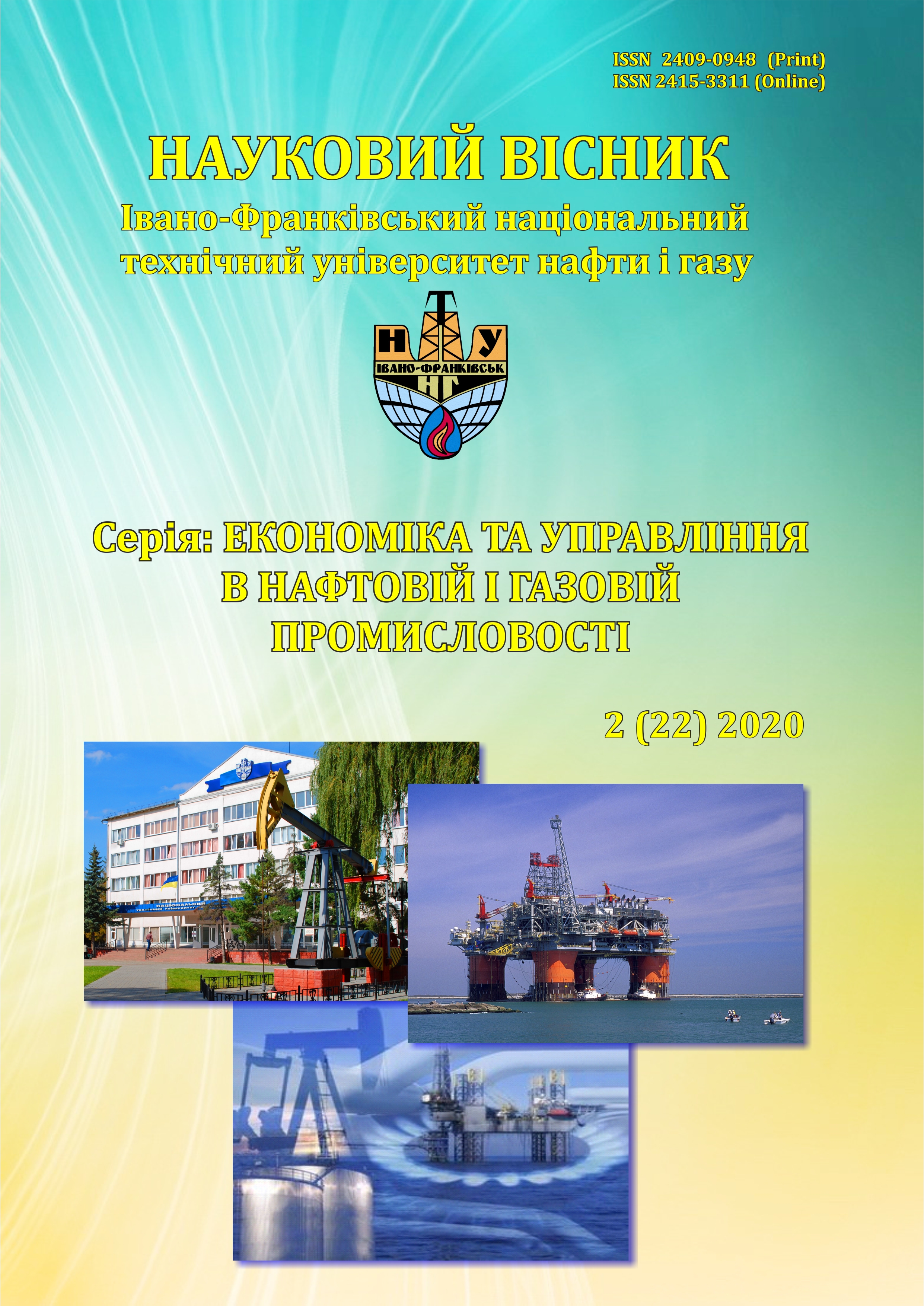CORPORATE CULTURE IN THE IMPLEMENTATION OF THE ENTERPRISE DEVELOPMENT STRATEGY
DOI:
https://doi.org/10.31471/2409-0948-2020-2(22)-60-71Keywords:
corporate culture, enterprise development, strategy, methods of OSAI, type and elements of corporate culture.Abstract
The relevance of the study of corporate culture as a tool for implementing the strategy of enterprise development is substantiated. Approaches to the interpretation of the concept of "corporate culture" are considered, which allowed to outline the elemental composition of corporate culture, identify sources of culture at the enterprise level, highlight its most important characteristics and prove the importance of corporate culture in implementing enterprise development strategy. The system of interconnections and interrelations through which the type of corporate culture at the enterprise is formed is found out. It is proved that the harmonization of corporate culture and strategy of the enterprise is an effective tool to ensure its further development. Methods of corporate culture diagnostics are considered and using the OCAI method, the type of corporate culture is determined on the example of a higher education institution, the directions of its improvement are revealed in terms of harmonization of the institution's strategy and elements and style of its corporate culture market of educational services. Corporate culture is presented as a system of personal and collective values, which, under ideal conditions, are accepted and shared by all members of the enterprise, and practically implemented through a set of norms, techniques, rules for solving problems of external adaptation and internal integration of employees. It is determined that the main purpose of the corporate culture of the enterprise is to harmonize its elements with the development strategy of the enterprise to ensure its sustainability and competitiveness. It is proved that the development of corporate culture of the university is an important aspect to solve existing problems and to ensure its success. In particular, further research should be developed in the context of developing specific tools and measures to change the type of corporate culture as a whole at the university and its individual components, which will practically achieve the strategic goals and ensure a competitive position in the market of educational services.
References
Iakovets I.O. Korporatyvna kultura v diialnosti muzeiu KhKhI stolittia. Visnyk: Dyzain osvita v Ukraini: perspektyvy rozvytku. 2013. №2. S. 61-65. URL: visnik.org/pdf/v2013-02-18-yakovets.pdf. [in Ukrainian].
Diakiv O.P. Osnovni skladovi formuvannia korporatyvnoi kultury v orhanizatsii. Formuvannia rynkovoi ekonomiky. Sotsialno-trudovi vidnosyny: teoriia i praktyka. 2010. T.3 S. 94-100. URL: https://core.ac.uk/download/pdf/32607044.pdf. [in Ukrainian].
Hrytsenko N. V. Korporatyvna kultura yak element systemy upravlinnia personalom. Visnyk NTU «KhPI» 2018. №15 (1291). S. 17-20. URL: https://core.ac.uk/reader/161786780. [in Ukrainian].
Robbyns S., Koulter M. Menedzhment, per. s anhl. O. V. Medved; M.: Yzdat. dom «Vyliams», 2007. 1056 s. [in USA].
Chaika H. P. Kultura dilovoho spilkuvannia menedzhera: navch.posib. K.: Znannia, 2005. 442 s. [in Ukrainian].
Spyvak V. A. Korporatyvnaia kultura. SPb.: Pyter, 2001.352 s. [in Russia].
Hrynenko A., Ishchanova M. Korporatyvna kultura sotsialno-vidpovidalnoho banku. Ukraina: aspekty pratsi. 2015. №2. URL: https://core.ac.uk/download/pdf/197271373.pdf [in Ukrainian].
Pryimak N. S. Korporatyvna kultura v systemi upravlinnia zminamy pidpryiemstva. VISNYK ZhDTU. 2019. № 2 (88). S. 91-97. DOI: https://doi.org/10.26642/jen-2019-2(88)-91-97 [in Ukrainian].
Savchuk L. Rozvytok korporatyvnoi kultury v Ukraini. Personal. 2005. №5. URL: http://personal.in.ua/article.php?ida=68 [in Ukrainian].
Fishchuk N.Iu., Lomachynska I.V. Korporatyvna kultura orhanizatsii: sutnist, vydy, pryntsypy ta vplyv na rozvytok orhanizatsii. Zbirnyk naukovykh prats VNAU. Seriia: Ekonomichni nauky. 2012. №1 (56). Tom 4. S. 81-85. URL: http://econjournal.vsau.org/ files/pdfa/691.pdf [in Ukrainian].
Iatskevych I.V. Ekonomichna diahnostyka: navch. posib. Odesa: FOP Bondarenko M.O., 2015. 292 s.URL: https://pidru4niki.com/86877/ekonomika/ekonomichna_diagnostika [in Ukrainian].
Tretiakova O. V. Korporatyvna kultura yak faktor realizatsii stratehii rozvytku pidpryiemstva. Prychornomorski ekonomichni studii. Seriia: Ekonomika ta upravlinnia pidpryiemstvamy. 2017. Vyp. 13-1. 111-114. [in Ukrainian].
Walker, H., Symon, G., Davies, B. Assessing Organizational Culture: A Comparison of Methods. International journal of selection and assessment. April 1996. DOI: https://doi.org/10.1111/j.1468-2389.1996.tb00064.x [in USA].
Kameron K., Kuynn R. Dyahnostyka y yzmenenye orhanyzatsyonnoi kulturы. SPb: Pyter, 2001. 320 s. [in Russia].
A Simple Organizational Culture Assessment Questionnaire. URL: https://worldofwork.io/2019/07/organizational-culture-assessment-questionnaire/.[in USA].
Ali Alshaher. The McKinsey 7S Model framework for E–learning system readiness assessment. International Journal of Advances in Engineering & Technology, Nov. 2013. Vol. 6, Issue 5, pp. 1948-1966. [in USA].
Shein Е. Orhanyzatsyonnaia kultura y lyderstvo. SPb.: Pyter, 2007. 336 s. [in Russia].
Kharchyshyna O.V. Porivniannia metodolohichnykh pidkhodiv do otsinky orhanizatsiinoi kultury ta perspektyvy yikh vykorystannia na pidpryiemstvakh kharchovoi promyslovosti. Ekonomika. Upravlinnia. Innovatsii. Seriia: Ekonomichni nauky. 2011. № 1. URL: http://eprints.zu.edu.ua/.pdf. [in Ukrainian].
Downloads
Published
How to Cite
Issue
Section
License
Copyright and Licensing Terms
Copyright Statement
The authors who publish in the journal accept the following conditions:
- The authors retain the copyright and grant the journal the right of first publication, licensed with Creative CommonsCC BY-NC-SA , which permits other people to remix, transform, and build upon the material and use the material for non-commercial purposes, give appropriate credit and distribute the contributions under the same license as the original.
- The authors can conclude additional agreements on the non-exclusive distribution of the journal’s published version of the work (for example, publication of the work in electronic repositories) with an acknowledgment of its initial publication in this journal.
- The authors can upload the published articles on the Internet (for example, in electronic repositories or on web-sites), as it will stimulate fruitful scholarly discussions and increase the citation rates of the published articles.


1.png)


1.png)





